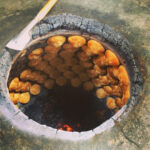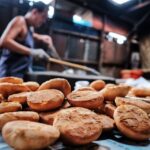Heong Peah: The Flaky Fragrant Biskuit of Perak
Heong Peah (also commonly known as Heong Peng/Biskut Wangi) is a popular Malaysian pastry/biscuit, especially in Perak. It features a sweet, sticky filling made from maltose and shallots, encased in a flaky baked crust and garnished with sesame seeds. The outer crust is incredibly crispy, leading to delightful crumbs falling, while the inner maltose filling boasts a rich and flowing consistency akin to lava. Originally resembling a water chestnut, it earned the name “马蹄酥” (Water Chestnut Pastry), later evolving into “香饼” (Fragrant Biscuit) due to its enticing aroma during baking.
Originating from Fujian, China, Heong Peah was initially a royal delicacy. Gradually, it transitioned from the imperial court to the common people, evolving in shape, fillings, and flavours. In Malaysia, it was introduced by Fujian immigrants that migrated to Perak, adapting over a century to incorporate local ingredients like flour, maltose, and sugar, replacing the original palace recipe. Heong Peah is particularly renowned in Perak towns like Teluk Intan, Ipoh, Taiping, and Gunung Rapat for producing this delicious and fragrant biscuit.
The process of making Heong Peah involves meticulous steps. It involves the preparation of two dough types—water dough and oil dough. The oil dough, composed of oil and flour, contributes to the crispy texture of the upper pastry layer. The unique layering textureof Heong Peah is achieved through a manual folding process, preferably done in the cool morning hours to prevent the pastry from drying and cracking. The filling comprises sugar, malt, fried shallots, roasted sesame seeds, salt, shallot oil, and a small amount of flour, creating a flavourful mixture. During the dough kneading process, the baker concurrently burns coconut shells in the kiln, utilizing them as natural and cost-effective fuel. The Heong Peah dough is then hand-applied to the kiln walls. The baking, lasting no more than 20 minutes, results in a golden brown color, a delightful aroma, and a crispy crust with a molten-like filling when bitten into.
In Malaysia, the pastry has evolved, and besides the traditional maltose filling, varieties such as durian, coffee, and pandan flavours have been introduced. Modern, less labourious methods of preparation are adopted nowadays, involving kneading machines and conventional ovens.
Heong Peah is commonly found in local bakeries, especially in areas with a significant Chinese population. It is a popular traditional pastry sold in small units to maintain freshness. Family-owned factories, often identified by their house numbers, produce these biscuits, hanging signs outside to attract customers with the irresistible aroma. The biscuit is sensitive to moisture, and its popularity has led to its widespread availability in various Malaysian cities like Penang, Kedah, Malacca, and Johor.





